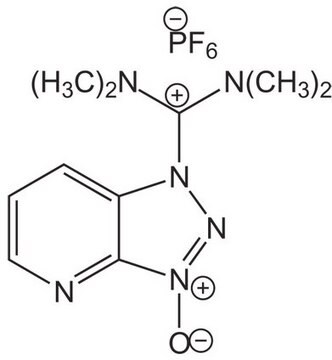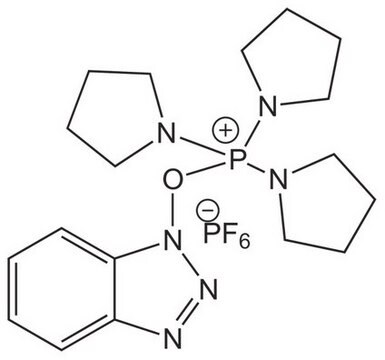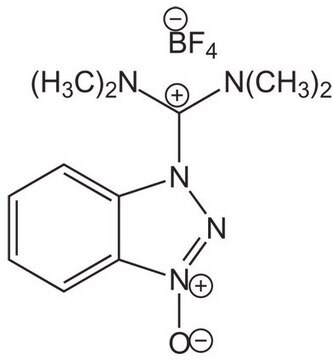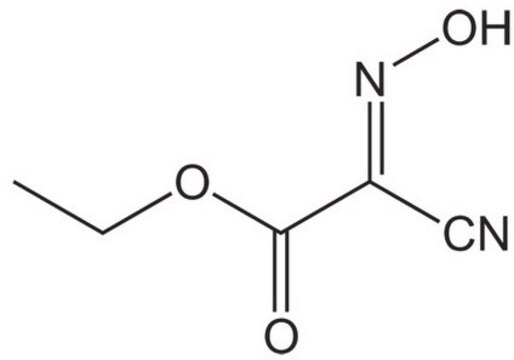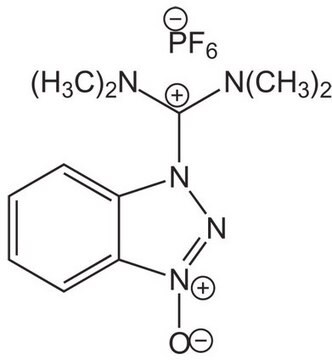8.51012
HCTU
O-(1H-6-Chlorobenzotriazole-1-yl)-1,1,3,3-tetramethyluronium hexafluorophosphate Novabiochem®
Synonim(y):
2-(6-Chloro-1-H-benzotriazole-1-yl)-1,1,3,3-tetramethylaminium hexafluorophosphate, HCTU
About This Item
Polecane produkty
Poziom jakości
linia produktu
Novabiochem®
Próba
≥98% (HPLC)
Postać
powder
przydatność reakcji
reaction type: Coupling Reactions
producent / nazwa handlowa
Novabiochem®
mp
>185 °C
Zastosowanie
peptide synthesis
temp. przechowywania
2-8°C
InChI
1S/C11H15ClN5O.F6P/c1-15(2)11(16(3)4)18-17-10-7-8(12)5-6-9(10)13-14-17;1-7(2,3,4,5)6/h5-7H,1-4H3;/q+1;-1
Klucz InChI
ZHHGTMQHUWDEJF-UHFFFAOYSA-N
Opis ogólny
Associated Protocols and Technical Articles
Guide to Selection of Coupling Reagents
Literature references
[1] O. Marder, et al. (2002) Chimica Oggi, 37.
[2] G. Sabatino, et al. in ′Peptides 2002, Proceedings of the 27th European Peptide Symposium′, E. Benedetti & C. Pedone (Eds), Naples, Edizioni Ziino, 2002, pp. 272.
[3] M. Gude & S. Barthélémy in ′Peptides 2002, Proceedings of the 27th European Peptide Symposium′, E. Benedetti & C. Pedone (Eds), Naples, Edizioni Ziino, 2002, pp. 122.
[4] G. Sabatino, et al. in ′Peptide Revolution: Genomics, Proteomics & Therapeutics, , Proc. 18th American Peptide Symposium′, M. Chrev & T. K. Sawyer (Eds), Cardiff, American Peptide Society, 2003, pp. 49.
Zastosowanie
- High-throughput parallel synthesis optimization of Glucagon-like Peptide 1 receptor agonists: Describes the use of HCTU as a reactive coupling reagent in peptide synthesis, highlighting its effectiveness in the production of GLP-1 agonists. (Ramos-Colón et al., 2018).
- An efficient synthesis of quinoxaline derivatives using HCTU as catalyst in DMF: Outlines a novel method for synthesizing quinoxaline and its derivatives using HCTU, highlighting its catalytic properties in facilitating efficient chemical reactions. (Sasane et al., 2023).
- An efficient one-pot conversion of carboxylic acids into benzimidazoles via an HBTU-promoted methodology: Describes the use of HCTU in a methodology to convert carboxylic acids into benzimidazoles, noting its role alongside other carbodiimide agents. (Barasa and Yoganathan, 2018).
Powiązanie
Komentarz do analizy
Appearance of substance (visual): powder
Identity (IR): passes test
Assay (HPLC, area%): ≥ 98.0 % (a/a)
Solubility (1 mmole in 2 ml DMF): clearly soluble
Water (K. F.): ≤ 0.50 %
To see the solvent systems used for TLC of Novabiochem® products please click here.
Informacje prawne
Hasło ostrzegawcze
Warning
Zwroty wskazujące rodzaj zagrożenia
Zwroty wskazujące środki ostrożności
Klasyfikacja zagrożeń
Skin Sens. 1A
Kod klasy składowania
11 - Combustible Solids
Klasa zagrożenia wodnego (WGK)
WGK 3
Temperatura zapłonu (°F)
Not applicable
Temperatura zapłonu (°C)
Not applicable
Certyfikaty analizy (CoA)
Poszukaj Certyfikaty analizy (CoA), wpisując numer partii/serii produktów. Numery serii i partii można znaleźć na etykiecie produktu po słowach „seria” lub „partia”.
Masz już ten produkt?
Dokumenty związane z niedawno zakupionymi produktami zostały zamieszczone w Bibliotece dokumentów.
Klienci oglądali również te produkty
Produkty
Novabiochem® offers a large number of coupling reagents for in situ activation. In situ activating reagents are easy to use, fast reacting – even with sterically hindered amino acids, and their use is generally free of side reactions.
Odczynniki sprzęgające Novabiochem® do aktywacji in situ szybko reagują i są kompatybilne z różnymi aminokwasami.
Nasz zespół naukowców ma doświadczenie we wszystkich obszarach badań, w tym w naukach przyrodniczych, materiałoznawstwie, syntezie chemicznej, chromatografii, analityce i wielu innych dziedzinach.
Skontaktuj się z zespołem ds. pomocy technicznej

